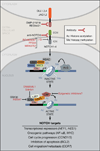From fly wings to targeted cancer therapies: a centennial for notch signaling
- PMID: 24651013
- PMCID: PMC4040351
- DOI: 10.1016/j.ccr.2014.02.018
From fly wings to targeted cancer therapies: a centennial for notch signaling
Abstract
Since Notch phenotypes in Drosophila melanogaster were first identified 100 years ago, Notch signaling has been extensively characterized as a regulator of cell-fate decisions in a variety of organisms and tissues. However, in the past 20 years, accumulating evidence has linked alterations in the Notch pathway to tumorigenesis. In this review, we discuss the protumorigenic and tumor-suppressive functions of Notch signaling, and dissect the molecular mechanisms that underlie these functions in hematopoietic cancers and solid tumors. Finally, we link these mechanisms and observations to possible therapeutic strategies targeting the Notch pathway in human cancers.
Copyright © 2014 Elsevier Inc. All rights reserved.
Figures




Similar articles
-
Notch signaling as a therapeutic target for breast cancer treatment?Breast Cancer Res. 2011 May 31;13(3):210. doi: 10.1186/bcr2875. Breast Cancer Res. 2011. PMID: 21672271 Free PMC article. Review.
-
An RBPJ-Drosophila Model Reveals Dependence of RBPJ Protein Stability on the Formation of Transcription-Regulator Complexes.Cells. 2019 Oct 14;8(10):1252. doi: 10.3390/cells8101252. Cells. 2019. PMID: 31615108 Free PMC article.
-
Eyeing tumorigenesis: Notch signaling and epigenetic silencing of Rb in Drosophila.Bioessays. 2006 Jul;28(7):692-5. doi: 10.1002/bies.20428. Bioessays. 2006. PMID: 16850405
-
The Notch Signaling Pathway Is Balancing Type 1 Innate Lymphoid Cell Immune Functions.Front Immunol. 2018 Jun 7;9:1252. doi: 10.3389/fimmu.2018.01252. eCollection 2018. Front Immunol. 2018. PMID: 29930552 Free PMC article.
-
NOTCH Signaling Pathway: Occurrence, Mechanism, and NOTCH-Directed Therapy for the Management of Cancer.Cancer Biother Radiopharm. 2024 Feb;39(1):19-34. doi: 10.1089/cbr.2023.0023. Epub 2023 Oct 5. Cancer Biother Radiopharm. 2024. PMID: 37797218 Review.
Cited by
-
Therapeutic Targeting of Signaling Pathways Related to Cancer Stemness.Front Oncol. 2020 Aug 26;10:1533. doi: 10.3389/fonc.2020.01533. eCollection 2020. Front Oncol. 2020. PMID: 32984007 Free PMC article. Review.
-
Structural analysis of Notch-regulating Rumi reveals basis for pathogenic mutations.Nat Chem Biol. 2016 Sep;12(9):735-40. doi: 10.1038/nchembio.2135. Epub 2016 Jul 18. Nat Chem Biol. 2016. PMID: 27428513 Free PMC article.
-
BMP-4 enhances epithelial mesenchymal transition and cancer stem cell properties of breast cancer cells via Notch signaling.Sci Rep. 2019 Aug 13;9(1):11724. doi: 10.1038/s41598-019-48190-5. Sci Rep. 2019. PMID: 31409851 Free PMC article.
-
Role of cytoplasmic lncRNAs in regulating cancer signaling pathways.J Zhejiang Univ Sci B. 2019 Jan.;20(1):1-8. doi: 10.1631/jzus.B1800254. J Zhejiang Univ Sci B. 2019. PMID: 30614225 Free PMC article. Review.
-
Notch Signaling Molecules as Prognostic Biomarkers for Acute Myeloid Leukemia.Cancers (Basel). 2019 Dec 6;11(12):1958. doi: 10.3390/cancers11121958. Cancers (Basel). 2019. PMID: 31817634 Free PMC article.
References
-
- Aifantis I, Raetz E, Buonamici S. Molecular pathogenesis of T-cell leukaemia and lymphoma. Nature reviews Immunology. 2008;8:380–390. - PubMed
-
- Akhoondi S, Sun D, von der Lehr N, Apostolidou S, Klotz K, Maljukova A, Cepeda D, Fiegl H, Dafou D, Marth C, et al. FBXW7/hCDC4 is a general tumor suppressor in human cancer. Cancer research. 2007;67:9006–9012. - PubMed
Publication types
MeSH terms
Substances
Grants and funding
LinkOut - more resources
Full Text Sources
Other Literature Sources
Molecular Biology Databases
Miscellaneous

